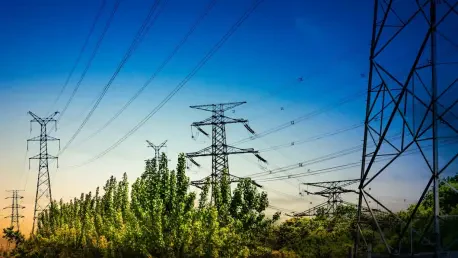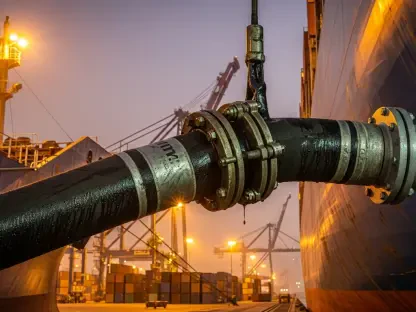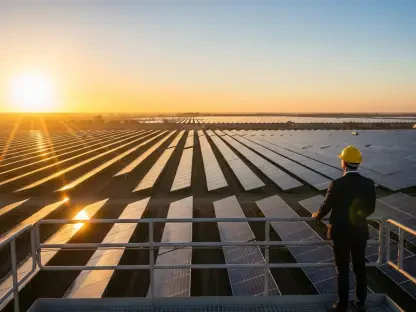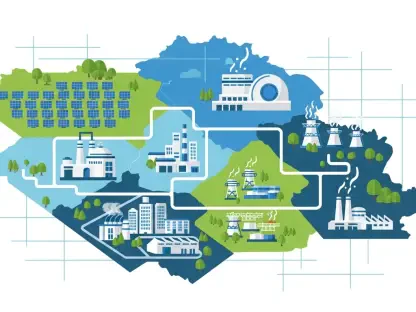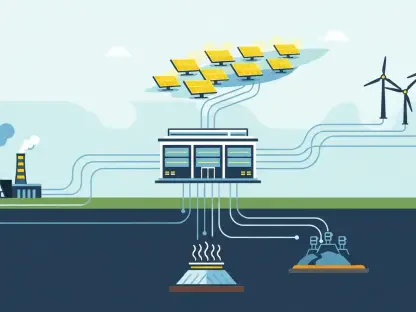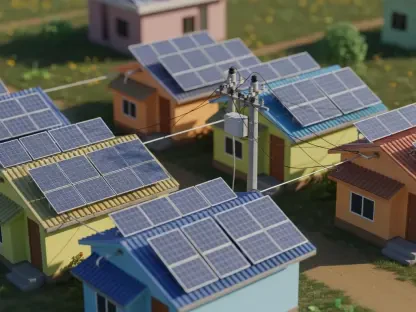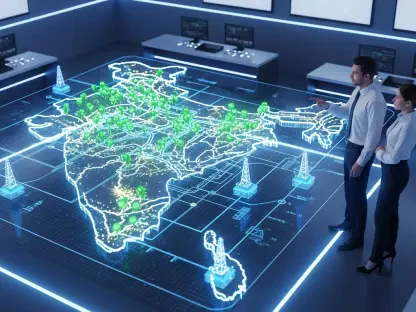The Looming Power Grid Crisis: A Call for Action and Profit
Imagine a sweltering summer day in the Mid-Atlantic, where millions are left without power due to a sudden grid failure, or a freezing winter night in San Antonio, where storms cripple the energy supply for days, exposing the dire state of infrastructure. These real-world scenarios are not isolated incidents but stark reminders of a systemic fragility plaguing the U.S. power grid. The aging infrastructure, increasingly severe climate-driven disruptions, and skyrocketing demand are pushing the system to its breaking point. This crisis, while a significant societal challenge, also unveils a rare chance for investors to capitalize on the urgent need for energy resilience and innovation.
The vulnerabilities of the grid—decades-old equipment, exposure to extreme weather, and an inability to keep pace with modern energy needs—demand immediate attention. These issues are no longer just technical hurdles; they disrupt lives, halt businesses, and threaten economic stability across regions. Yet, within this turmoil lies an opportunity to fund and develop transformative solutions that not only address these shortcomings but also promise substantial returns. The stage is set for stakeholders to turn a national liability into a profitable venture by focusing on modernization and sustainable energy systems.
This guide aims to equip investors and stakeholders with the knowledge to navigate this critical landscape, identifying key areas where capital can drive both impact and profit. By understanding the root causes of the grid’s failures and exploring strategic investment pathways, readers can position themselves at the forefront of a rapidly evolving sector. The dual focus on societal benefit and financial gain makes this an unparalleled moment to engage with the energy market’s transformation.
Unpacking the Grid’s Vulnerabilities: Why It’s Breaking Down
The U.S. power grid, a sprawling network that powers homes and industries, is buckling under the weight of its own obsolescence. A staggering 70% of transformers in operation today are over 25 years old, well past their optimal lifespan, while 60% of circuit breakers have exceeded 30 years. These aging components are ill-equipped to handle current demands, leading to frequent failures, especially in distribution systems that account for 92% of all outages. This outdated foundation is a ticking time bomb waiting for the next trigger to cause widespread disruption.
Compounding this issue is the relentless impact of weather-related events, which have been responsible for 80% of outages from 2000 to the present day. The frequency and intensity of these disruptions have doubled over recent decades due to climate change, with severe storms and heatwaves exposing the grid’s inability to adapt. Beyond natural threats, human-induced risks such as cybersecurity breaches add another layer of concern, as digital vulnerabilities leave critical infrastructure open to attack. These combined factors paint a picture of a system struggling to maintain reliability.
Moreover, the demand for electricity is surging at an unprecedented rate, driven by the rise of electric vehicles, data centers, and industrial electrification. Projections indicate a 15% increase in peak summer demand by 2034, a growth the current grid is unprepared to meet. Supply chain bottlenecks further exacerbate the problem, with transformer lead times stretching from a manageable duration to over 120 weeks as of recent reports. This convergence of outdated infrastructure, environmental pressures, and logistical delays underscores the urgent need for comprehensive investment and reform to prevent cascading failures.
Pathways to Resilience: Key Strategies for Grid Modernization
Addressing the grid crisis requires a multifaceted approach, blending cutting-edge technology with forward-thinking policies. Modernization efforts must prioritize both immediate fixes and long-term sustainability to ensure reliability amid growing challenges. The following steps outline critical strategies that investors and stakeholders can support to transform vulnerabilities into strengths.
These strategies not only aim to fortify the grid against current threats but also prepare it for future demands. By focusing on innovation and decentralization, the energy sector can move toward a more resilient framework. Below are detailed pathways to achieve this transformation, each offering unique opportunities for impactful investment.
Step 1: Embracing Grid-Enhancing Technologies (GETs)
One of the most immediate ways to bolster the grid is through the adoption of grid-enhancing technologies, which optimize existing infrastructure without the need for costly overhauls. Technologies such as dynamic line ratings (DLRs) and advanced power flow controllers allow for real-time adjustments to transmission capacity, significantly reducing bottlenecks. A notable example is PPL Electric’s deployment of DLRs in Pennsylvania, a project anticipated to decrease congestion by 65% by 2028, demonstrating the tangible impact of such innovations.
Maximizing Transmission Efficiency
The beauty of GETs lies in their ability to enhance the performance of current systems cost-effectively. By dynamically adjusting to environmental conditions and demand fluctuations, these tools maximize the throughput of transmission lines, delaying the need for extensive new construction. This approach not only saves capital but also speeds up implementation, offering a practical solution for regions facing immediate capacity constraints. Investors can find substantial value in backing companies and projects that prioritize these efficient upgrades.
Step 2: Investing in Decentralized Energy Solutions
Another pivotal strategy is the shift toward decentralized energy systems, which reduce reliance on a centralized grid prone to widespread failures. Microgrids and battery energy storage systems (BESS) provide localized power solutions, ensuring continuity during outages. CPS Energy’s Community Energy Resiliency program in San Antonio, supported by a $30 million federal grant, exemplifies how such initiatives can strengthen community-level reliability with scalable, independent energy sources.
Empowering Local Resilience
Decentralized systems empower communities by offering a buffer against grid-wide disruptions, particularly in areas vulnerable to natural disasters. These solutions enable hospitals, schools, and essential services to maintain operations even when the larger network fails. For investors, supporting firms that develop or deploy microgrids and storage technologies presents a chance to tap into a growing market while contributing to societal stability, especially in underserved regions.
Step 3: Strengthening Cybersecurity Defenses
As the grid becomes more digitized, the threat of cyberattacks looms larger, with 95 incidents reported in the first half of 2023 alone. Protecting critical infrastructure from digital threats is no longer optional but a necessity, underscored by $1 billion in federal funding allocated for grid cybersecurity. This investment signals a clear priority to safeguard energy systems from human-related disruptions that could rival the impact of natural disasters.
Safeguarding Against Digital Threats
Cybersecurity measures, ranging from advanced encryption to threat detection software, are essential to fortify the grid against malicious interference. Companies specializing in these defenses are becoming integral to energy security, offering robust solutions to prevent outages caused by breaches. Stakeholders looking to invest in this space can align with specialists addressing these emerging risks, ensuring both protection and profitability in a digitally dependent era.
Step 4: Leveraging Smart Grid Innovations
Smart grid technologies represent the future of energy management, incorporating real-time monitoring and self-healing systems to enhance reliability. Backed by $3 billion in Grid Resilience and Innovation Partnerships (GRIP) grants, these innovations enable the grid to detect and respond to faults autonomously. Such advancements are crucial for minimizing downtime and improving overall system efficiency in the face of growing complexity.
Building a Self-Adapting Energy Network
The implementation of smart grids facilitates a proactive approach to energy distribution, using data analytics and automation to predict and mitigate issues before they escalate. This self-adapting capability not only reduces outage frequency but also supports long-term stability as demand patterns evolve. Investment in firms driving smart grid development offers a pathway to engage with a technology poised to redefine how energy is managed and delivered across the nation.
Snapshot of Investment Hotspots: Where to Focus
For those ready to act, certain sectors stand out as prime areas for investment in the grid’s transformation. Battery storage is a leading field, with companies like Tesla (TSLA) and Fluence (FLNC) at the forefront of scalable solutions. Grid modernization also presents significant potential, driven by firms such as Schneider Electric (SU) and ABB (ABB), which are pivotal in upgrading infrastructure.
Renewable energy continues to gain traction, with developers like NextEra Energy (NEE) and Brookfield Renewable Partners (BEP) expanding capacity to meet clean energy goals. Cybersecurity, an often-overlooked but critical domain, features specialists like Dragos (DRGO) and Wiz (WIZ) tackling digital vulnerabilities. These sectors collectively provide a roadmap for investors to align with high-growth opportunities tied to the strategies outlined earlier.
Future Outlook: Trends Shaping the Energy Landscape
Looking ahead, the transition from a centralized to a decentralized energy network marks a defining shift in the industry. Supported by federal policies such as the Infrastructure Investment and Jobs Act (IIJA), which targets the upgrade of 100,000 miles of transmission lines and aims to add 20–100 GW of capacity by 2030, this evolution is gaining momentum. Such initiatives reflect a commitment to building a grid capable of withstanding modern challenges while integrating renewable sources.
However, potential obstacles like regulatory complexities and supply chain constraints could slow progress. Addressing these hurdles will require coordinated efforts between public and private sectors to ensure timely deployment of solutions. Despite these challenges, the societal benefits—improved reliability and equitable energy access, particularly in disadvantaged communities—highlight the broader impact of these investments.
The trend toward decentralization also aligns with a growing emphasis on sustainability and resilience. As policies and technologies converge, the energy landscape is set to become more adaptive, prioritizing local empowerment and environmental responsibility. Investors who anticipate and support these shifts stand to benefit from both immediate project gains and long-term market growth in an increasingly dynamic sector.
Seizing the Moment: Final Thoughts and Next Steps
Reflecting on the journey through the U.S. power grid crisis, the exploration of vulnerabilities and solutions paints a vivid picture of an industry at a crossroads. Each step, from embracing grid-enhancing technologies to fortifying cybersecurity, carves out a path that stakeholders can navigate to transform challenges into opportunities. The convergence of public funding and private innovation provides a robust foundation for those who take decisive action.
Beyond the strategies discussed, the next steps involve deeper research into specific sectors like energy storage and cybersecurity, where rapid advancements continue to unfold. Partnerships with grant-supported projects offer a practical way to maximize impact and profitability, ensuring alignment with scalable initiatives. Engaging with industry reports and connecting with leading firms in the space become essential for staying ahead in this evolving market.
Ultimately, the focus shifts to envisioning a resilient grid as a legacy of these efforts, one that not only meets current demands but also anticipates future needs. Stakeholders are encouraged to explore regional opportunities where modernization efforts are most urgent, leveraging federal and state incentives to drive meaningful change. This proactive stance promises to shape a more reliable and equitable energy future for all.
